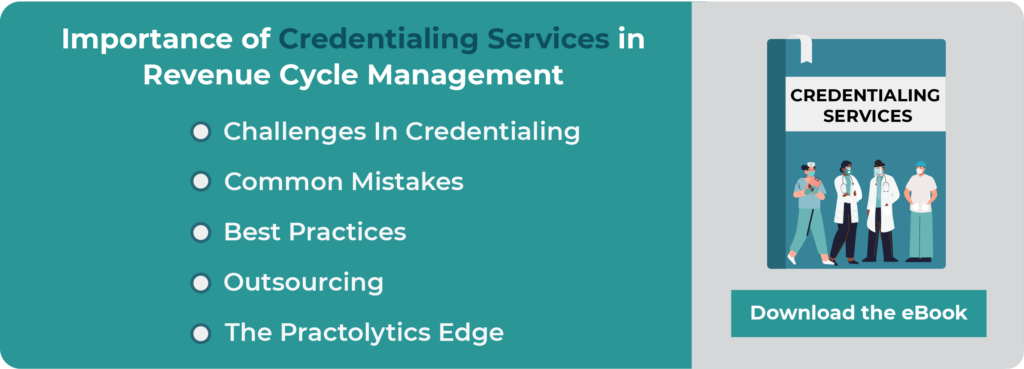How Slow Credentialing Creates 90 Days Revenue Gaps for Healthcare Providers
How Slow Credentialing Creates 90 Days Revenue Gaps for Healthcare Providers begins with a simple truth: credentialing isn’t glamorous. It’s paperwork, verifications, and countless follow-up calls — the behind-the-scenes work that keeps clinicians paid and patients able to use their insurance. Yet many practices still treat credentialing as a routine administrative checkbox. The result is a common and costly reality: a 90-day delay between hiring a provider and securing active payer enrollment. That delay isn’t just inconvenient; it’s a slow leak in your revenue bucket. This article breaks down the measurable costs of slow credentialing, the hidden points where delays occur, and the practical steps healthcare organizations can take to prevent unnecessary revenue gaps.
Table of Contents
Why 90 Days Matter
Three months of inactivity for a newly hired clinician or a newly contracted payer relationship has four immediate consequences.
Lost billable time. If the clinician can’t bill in-network, patients either pay out of pocket, Scheduling appointments are deferred, or revenue is billed out-of-network and later denied. A single full-time clinician unable to bill for 90 days can represent tens of thousands in lost charges depending on specialty and visit mix. For specialties with high procedure volumes, the loss can be far greater.
Higher patient collections burden. Patients who pay out of pocket often struggle—or don’t—to reimburse later.
Point-of-service collections are significantly more effective than post-visit statements in terms of collection rates. If the patients do not anticipate the bills, then the staff will have no choice but to engage more in outreach and payment-plan negotiations, therefore incurring a rise in administrative cost and stress.
Ineffective operations. Funding the staff for tracking credentialing, seeking primary source verifications, re-submitting documents, and fighting denials takes away from revenue capture and patient access. The hours spent on such activities may not be directly accounted for in the current staff roles, thus leading to burnout and reduced productivity in different areas.
Contract risk and referral leakage. Referring providers and patients will not be patient. A delay of 90 days in the onboarding process risks losing the referrals to other clinics that are credentialed. Lost referrals mean not only a decrease in short-term visits but also the erosion of long-term referral relationships which are very costly to rebuild.
Where the Delay Hides
Credentialing delays usually come from one or more of these friction points:
Incomplete initial packet. CAR 1-CAQH, contract-knowledge paper, and malpractice-prior information-and old CV make for an immediate decline or a need for further details.
Slow primary source verification (PSV). Medical schools, licensing boards, state agencies, and previous employers can take days or weeks to respond to PSV requests, especially when manual processes or holiday periods slow operations.
Provider turnover in credentialing teams. Gaps in staffing, overworked credentialing coordinators, or lack of a single accountable owner slow follow-up and increase the risk that items fall through the cracks.
Manual submission and tracking. Email threads, PDFs, and spreadsheets invite mistakes. Without a single system of record and automated reminders, actor handoffs create gaps and duplicate work.
Payer backlogs. Some payers have long internal processing windows and may require resubmission or clarification. Smaller payers or regional plans may be particularly slow or opaque about expected turnaround times.
The True Financial Impact — a Simple Model
Let’s take a conservative scenario. A family doctor, on average, makes $250 a visit, sees 20 patients each day and works for 20 days a month. A 90-day credentialing delay results in:
Lost visits: 20 × 20 × 3 = 1,200 visits.
Lost gross charges: 1,200 × $250 = $300,000.
Net impact (conservative): The revenue loss for the practice is $120,000, even with a 40% collection rate on the encounters in the long run.
This is merely for one doctor. When you consider another doctor, one doctor who has had less than one month of credentialing, or hospitals with more than one practice coping with this problem, one could say that the credentialing process turns out to be a great risk for cash flow management.
Practical Fixes that Reduce the 90-Day Gap
- Start credentialing immediately to offer acceptance. Begin the credentialing process when the candidate signs the offer, not on the first day. Open CAQH enrollment, collect W-9, malpractice information, attestation, and all necessary documentation as early as possible to shave weeks off processing time.
- Centralize and standardize packet checklists. Use a detailed pre-submission checklist that includes CAQH ID, board certification, malpractice policy, state license copies, DEA, NPI, photo ID, CV, references, and any specialty-specific certifications. Standard packets reduce resubmits.
- Automate reminders and follow-ups. Use credentialing software or simple automated email reminders for PSV tasks and document resubmissions. Automation reduces human forgetfulness and keeps PSV requests moving.
- Designate a credentialing owner and SLAs. Assign one accountable owner with defined SLAs—for example, complete the initial packet within five business days, follow up on PSV every seven days, and escalate unresponsive sources after 14 days. Clear ownership reduces handoff delays.
- Use payer-specific submission guides. Keep a payer guide that includes who verifies, average turnaround times, necessary special attachments, and any payer-specific peculiarities for each payer. Payer guides can minimize the number of resubmissions and make it faster for the payer to accept the claim.
- Quick revenue through bridge solutions is suggested. Immediate measures—like billing out-of-network with clear patient communication, medical billing under a supervising provider while credentialing (where legally permissible) is pending, or offering cash-pay options—can keep revenue coming in during the period of credentialing. Make sure to document all patient agreements and follow up to convert outstanding balances once in-network status has been granted.
- Measure and report credentialing KPIs. Track time-to-credential, completion rate, denials attributed to credentialing gaps, and revenue at risk. Report these KPIs in leadership meetings to prioritize resources and process improvements.
Tech and Outsourcing Options
Credentialing software can be used to streamline the process of verifying the credentials of physicians, managing documents in one place, and having seamless integration with the practice management systems. In the case that a practice does not have enough manpower for credentialing, outsourcing to either credentialing specialists or revenue-cycle partners will not only speed up the process but will also lessen the chances of making mistakes. Generally, the expense of outsourcing is compensated by the income gained through quicker credentialing and less denials.
Communicating with Patients Transparently
In case the credentialing delays lead to the use of out-of-network billing or alternative billing methods, it is imperative to have the personnel trained in a way that they will be able to clearly and confidently explain all the options: the time frame for the medical credentialing process, possible patient responsibility, and the financial assistance programs available. Communication that is clear and backed up by empathy will not only increase the chances of patient cooperation and subsequent payment but also safeguard the practice’s reputation.
Preventing Long-Term Damage to Referral Networks
Referral patterns may become irreversible if the referral sources experience constantly credentialing delays. The best way to counter this risk is by informing referring physicians in advance about the expected start dates, suggesting temporary appointment solutions, and providing excellent patient care throughout the waiting period. Quick reply and good communication maintain the referral partnerships.
Case Example — Quick Math for Small Groups
Envision a clinic consisting of three practitioners whose hiring was at different times apart and adding one specialty through a year. Even if every practitioner undergoes a credentialing delay of 60 days instead of 90, the clinic still loses a lot of money; the shortening of that average by only 30 days per the group can mean a recovery of tens of thousands annually — the money that can be used in staffing, equipment, or patient access programs. Compensating those gains with the cost of software or a credentialing vendor clarifies the return on investment.
Common Objections and Responses
“We don’t have a budget for software or a coordinator.” Start with low-cost wins: standardized packets, a single owner, and simple automated reminders before buying tools. Time saved from fewer denials often funds future investment.
“Payers are slow—nothing we can do.” Even when payers delay, improving submission quality, follow-up cadence, and escalation reduces round trips and speeds approvals.
A Final Word on ROI
Fixing credentialing isn’t just about staff efficiency — it directly protects cash flow. If one provider’s 90-day lag can cost a practice six figures in lost charges, even modest improvements in credentialing throughput pay for themselves. Early starts, standardized packets, automation, and clear ownership are the fastest wins. For many practices, the investment in a credentialing coordinator, credentialing software, or a credentialing vendor partnership pays off within a few months.
Next Steps for Practices
Start by outlining and delineating your existing credentialing process and recording the average time needed for credentialing. Pinpoint the main three areas that cause most problems and try out one or two solutions (e.g., a packet that is standardized and a person assigned with an SLA). Keep an eye on KPIs every week and proceed with the effective methods. If you want, Practolytics can assist with the process mapping, generating checklists for specific payers, and investigating the possibility of outsourcing parts of credentialing being financially beneficial for your practice.






